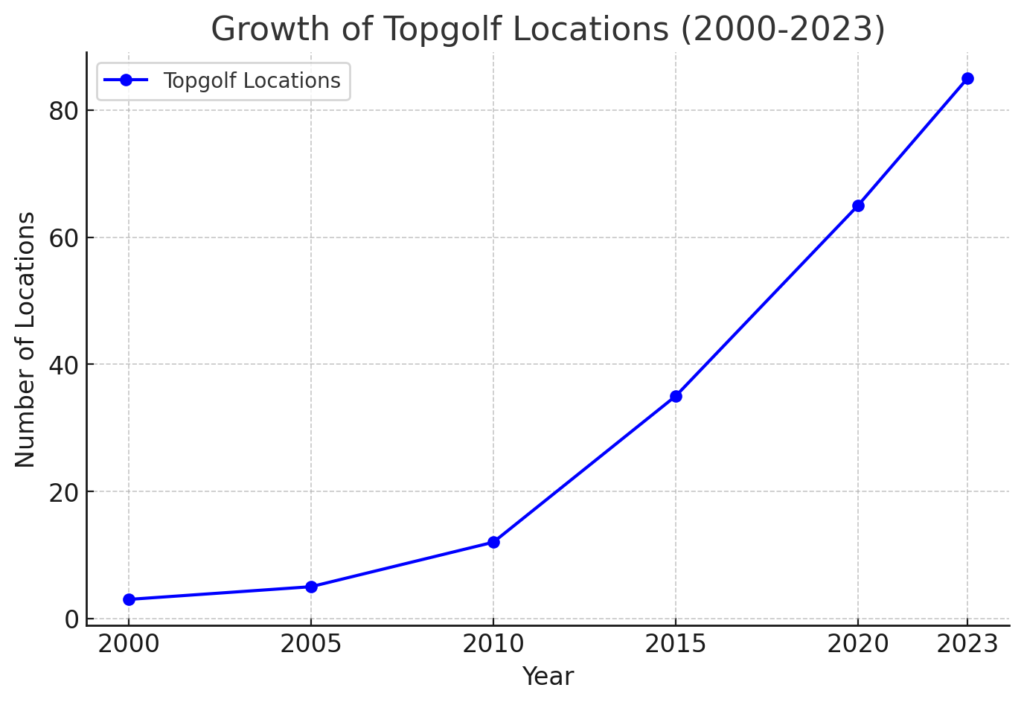Topgolf is not just another driving range—it’s a groundbreaking fusion of golf, technology, and social entertainment. What began as a niche idea in the United Kingdom in 2000 has evolved into a global franchise with locations spanning multiple countries. This article explores Topgolf’s origin, key milestones, expansion into the U.S. and beyond, and its transformation into a worldwide brand.

The Birth of Topgolf in the United Kingdom (2000–2005)
The Idea Behind Topgolf
Topgolf was founded in 2000 in Watford, England, by Steve and Dave Jolliffe, two brothers who were avid golfers. They recognized a problem—traditional driving ranges lacked excitement. They wanted to create an interactive, score-based golf experience that would appeal to both golfers and casual players.
The Key Innovation: Microchipped Golf Balls
The Jolliffe brothers introduced the idea of embedding microchips in golf balls to track distance and accuracy. This allowed players to receive instant feedback on their shots. Combined with a target-based scoring system, Topgolf introduced a game-like experience that made hitting golf balls fun for everyone.
The First Topgolf Locations
The first three Topgolf locations opened in the UK between 2000 and 2005:
- Watford (2000) – The first-ever Topgolf location.
- Chigwell (2004) – Expanded on the success of the Watford location.
- Addlestone (2005) – Opened the same year Topgolf entered the U.S.
Each of these locations saw rapid growth, drawing both golfers and newcomers who enjoyed the unique mix of competition and entertainment.
Expansion into the United States (2005–2014)
Topgolf Enters the U.S. Market
In 2005, Topgolf made its way across the Atlantic with the opening of its first U.S. venue in Alexandria, Virginia. The move was backed by a U.S. licensee and WestRiver Group, which saw the potential for expanding Topgolf in America.
Why the U.S. Market Took Off
Several factors contributed to Topgolf’s explosive growth in the U.S.:
- Larger entertainment culture – Americans love interactive experiences with food, drinks, and games.
- Growing interest in casual golf experiences – Many people wanted to enjoy golf without the strict rules of traditional courses.
- Urban-friendly design – Topgolf provided a golfing experience without the need for a full-sized course, making it popular in major metropolitan areas.
| Year | Milestone |
| 2005 | First U.S. venue opens in Alexandria, Virginia |
| 2006 | Callaway Golf invests in Topgolf |
| 2010 | Nationwide expansion accelerates |
| 2014 | Topgolf recognized as a major entertainment brand |
By 2014, Topgolf had firmly established itself in the U.S., with multiple locations in major cities, attracting millions of visitors annually.
Topgolf’s Explosive Growth (2014–2021)
Between 2014 and 2021, Topgolf saw massive expansion, both in the U.S. and internationally. The business model evolved beyond golf, incorporating advanced technology, social experiences, and premium hospitality.
Growth in the U.S.
By 2016, Topgolf had dozens of locations across the U.S., each offering a blend of sports, technology, and entertainment. The company also introduced corporate event packages, turning Topgolf into a prime destination for team-building activities and social gatherings.
International Expansion
Topgolf had already proven its success in the UK and U.S., but by the late 2010s, the company set its sights on global markets.
| Country | First Topgolf Location | Key Milestones |
| United Kingdom | Watford (2000) | Birthplace of Topgolf |
| United States | Alexandria, VA (2005) | Rapid growth, multiple locations |
| Australia | Gold Coast (2018) | First expansion into the Southern Hemisphere |
| Mexico | Monterrey (2020) | Entry into Latin America |
| United Arab Emirates | Dubai (2021) | Expansion into the Middle East |
Europe and Beyond
- Germany: Opened in 2021 (Berlin), tailored to Europe’s love for “competitive socializing.”
- Middle East: A Dubai venue (2023) features luxury bays and shisha lounges.
The Callaway Merger and Future Plans (2021–Present)
Callaway Golf’s Full Acquisition (2021)
Topgolf’s biggest corporate milestone came in 2021, when Callaway Golf—one of the largest golf equipment companies—acquired 100% ownership of Topgolf. This move officially made Topgolf a wholly owned subsidiary of Callaway Golf (NYSE: ELY).
Why Callaway Merged with Topgolf
- Shared vision – Both companies focused on making golf more accessible and engaging.
- Technology integration – Callaway’s resources could enhance Topgolf’s tracking systems and data analytics.
- Stronger brand synergy – Merging allowed Callaway to expand beyond equipment sales into entertainment and hospitality.
Current and Future Developments
Since the merger, Topgolf has been focusing on:
- Expanding smaller, city-friendly locations (like Topgolf Lounge)
- Enhancing ball-tracking technology for better shot analysis
- Introducing virtual Topgolf experiences through gaming partnerships
Visualizing Topgolf’s Growth: Locations Over Time
To better understand Topgolf’s growth, the graph below illustrates the number of venues worldwide since its inception.
Topgolf Venue Growth (2000–2023)

The chart above illustrates Topgolf’s rapid expansion, from just three locations in 2000 to over 85 venues worldwide by 2023. The steep growth curve highlights its increasing popularity and global reach.
Annual Visitor and Revenue Growth
| Year | Locations | Annual Visitors (Millions) | Revenue (USD Billion) |
| 2010 | 6 | 1.2 | 0.05 |
| 2015 | 22 | 8.5 | 0.4 |
| 2020 | 60 | 23.0 | 1.1 |
| 2023 | 83 | 33.0 | 1.8 |
Strategic Moves
- 2016: A $275 million investment from Providence Equity Partners accelerated expansion.
- 2020: Callaway Golf acquired Topgolf in a $2.6 billion merger, marrying golf equipment with entertainment.
Where Topgolf Stands Today
From three UK locations in 2000 to a global brand in 2024, Topgolf has redefined golf for a new generation.
Total Venues (2024):
- More than 80 locations worldwide
- Millions of visitors every year
What Makes It Unique?
- It’s Golf, but Fun: Topgolf removes golf’s usual barriers (expensive memberships, long games, strict etiquette).
- Tech-Driven & Data-Friendly: Microchipped balls, instant score tracking, and competitive leaderboards keep players engaged.
- International Growth Potential: Future expansion into Asia and Europe is likely.
